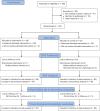Risk of Deep Vein Thrombosis After Acute Achilles Tendon Rupture: A Secondary Analysis of a Randomized Controlled Trial Comparing Early Controlled Motion of the Ankle Versus Immobilization
- PMID: 32426409
- PMCID: PMC7222258
- DOI: 10.1177/2325967120915909
Risk of Deep Vein Thrombosis After Acute Achilles Tendon Rupture: A Secondary Analysis of a Randomized Controlled Trial Comparing Early Controlled Motion of the Ankle Versus Immobilization
Abstract
Background: Immobilization of the ankle joint has been suggested as a key element in the pathogenesis leading to deep vein thrombosis (DVT).
Purpose: To investigate whether early controlled ankle motion (ECM) could reduce the incidence of DVT compared with immobilization (IM) in the treatment of acute Achilles tendon rupture.
Study design: Randomized controlled trial; Level of evidence, 2.
Methods: Patients aged 18 to 70 years were eligible for inclusion, and treatment was nonoperative. The ECM group performed movements of the ankle 5 times a day from weeks 3 to 8 after rupture. The control group was immobilized for 8 weeks. The outcome measure was DVT diagnosed with color Doppler ultrasound for above- and below-knee DVT at 2 and 8 weeks. The Achilles tendon Total Rupture Score, the heel-rise work test, and the Copenhagen Achilles ultrasonographic Length Measurement were performed at 4-, 6-, and 12-month follow-up.
Results: A total of 189 patients were assessed for eligibility from February 2014 to December 2016. Of these, 130 were randomized: 68 patients were allocated to the ECM group and 62 to the IM group. All patients participated in follow-up at 8 weeks assessing for DVT. In total, 62 (47.7%) patients were diagnosed with DVT: 33 of 68 (48.5%) in the ECM group and 28 of 61 (46.8%) in the IM group (P = .84). DVT did not affect treatment outcomes at 4, 6, and 12 months. D-dimer had low sensitivity (71%) for detecting DVT.
Conclusion: We found that 1 in 2 patients presented with DVT in nonoperative treatment of acute Achilles tendon rupture. The ECM protocol revealed no benefit versus IM in reducing the incidence of DVT. DVT did not influence functional and patient-reported outcomes the first year after rupture. D-dimer seems an inappropriate test for detection of DVT in patients with acute Achilles tendon rupture.
Registration: NCT02015364 (ClinicalTrials.gov identifier).
Keywords: DVT; acute Achilles tendon rupture; deep vein thrombosis; dynamic rehabilitation; early controlled motion.
© The Author(s) 2020.
Conflict of interest statement
One or more of the authors has declared the following potential conflict of interest or source of funding: Research support for this study was received from DJO Nordic (to K.W.B.) and from Gigtforeningen (the Danish Rheumatism Association). AOSSM checks author disclosures against the Open Payments Database (OPD). AOSSM has not conducted an independent investigation on the OPD and disclaims any liability or responsibility relating thereto.
Figures
References
-
- Andrews EJJ, Fleischer AC. Sonography for deep venous thrombosis: current and future applications. Ultrasound Q. 2005;21(4):213–225. - PubMed
-
- Arverud ED, Anundsson P, Hardell E, et al. Ageing, deep vein thrombosis and male gender predict poor outcome after acute Achilles tendon rupture. Bone Joint J. 2016;98-B(12):1635–1641. - PubMed
-
- Barfod KW, Bencke J, Lauridsen HB, Ban I, Ebskov L, Troelsen A. Nonoperative dynamic treatment of acute Achilles tendon rupture: the influence of early weight-bearing on clinical outcome: a blinded, randomized controlled trial. J Bone Joint Surg Am. 2014;96(18):1497–1503. - PubMed
Associated data
LinkOut - more resources
Full Text Sources
Medical



